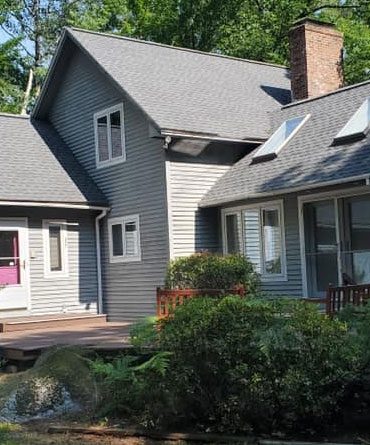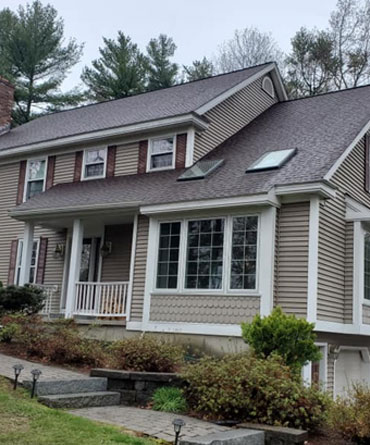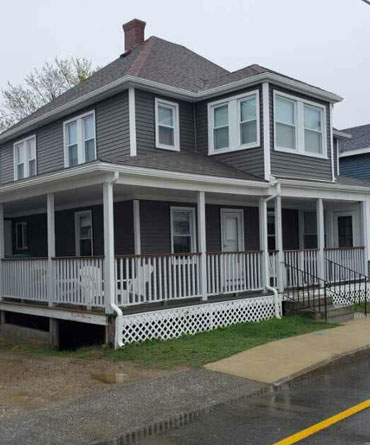Introduction
Roof ventilation is an aspect of home maintenance that is often overlooked, yet it plays a pivotal role in ensuring the longevity and overall health of your home. It is a system designed to create a flow of air that involves the movement of air from the outside to the inside of the roof. This is essential in maintaining a balanced air temperature between the attic and the roof. Without proper roof ventilation, a myriad of problems can arise, including heat and moisture buildup that can lead to the deterioration of your roof’s foundation.
The importance of roof ventilation goes beyond just preserving the structural integrity of your home. It also contributes significantly to the energy efficiency of your living spaces. In the summer months, proper ventilation prevents heat buildup, reducing the need for air conditioning and, therefore, saving on energy bills. Similarly, in the winter, it serves to eliminate moisture buildup, which can help maintain a dry and warm interior environment.
This article aims to demystify the concept of roof ventilation, explain its importance, and provide tips on how to ensure your roof is adequately ventilated. By understanding the basics of roof ventilation, homeowners can make more informed decisions about their home maintenance and potentially prevent costly future damages. The following sections will delve deeper into types of roof ventilation, the role of insulation in roof ventilation, how to identify signs of poor roof ventilation, and guidelines for proper roof ventilation.
Understanding Roof Ventilation
Roof ventilation is a system that allows air to circulate effectively in the attic, controlling temperature and moisture levels. It is designed to regulate air intake and outflow, ensuring fresh air enters and stale air exits the roof space.
How Roof Ventilation Works
The principle behind roof ventilation is based on natural convection. Hot, moist air rises and escapes from the highest point, while cooler air is drawn in from lower points. This process mitigates heat and moisture buildup.
Benefits of Roof Ventilation
Roof ventilation maintains structural integrity by preventing moisture-induced damage and enhancing energy efficiency. It prevents condensation, mold, and rot, and reduces the risk of ice dams in colder climates.
Roof Ventilation and Energy Savings
Proper ventilation reduces the cooling load on air conditioning systems, saving energy and lowering utility bills. Understanding this aspect is essential for effective building maintenance.
The Need for Roof Ventilation
Prevents the Build-Up of Heat and Moisture
In the realm of building maintenance and energy efficiency, the need for roof ventilation cannot be overstated. One of the primary reasons why roof ventilation is essential is that it prevents the build-up of heat and moisture. Over time, excessive heat and humidity can lead to a myriad of problems, such as the growth of mold and mildew, which can negatively impact the health of the building’s occupants. Moreover, the trapped heat can cause your cooling systems to work overtime, leading to increased energy consumption and higher utility bills.
Preserves the Roof’s Structural Integrity
Beyond maintaining a comfortable indoor temperature, roof ventilation also plays a crucial role in preserving the roof’s structural integrity. When moisture seeps into the roofing materials and gets trapped, it can cause rot and deterioration. Over time, this can compromise the roof’s structural integrity, leading to costly repairs or even a complete roof replacement. Proper ventilation allows this moist, hot air to escape, thereby extending the lifespan of the roof.
Contributes to Energy Efficiency
Another noteworthy advantage of roof ventilation is its contribution to energy efficiency. A well-ventilated roof can significantly reduce the cooling load on air conditioning systems during the warmer months. By allowing hot air to escape, the air conditioner doesn’t have to work as hard to cool down the building, resulting in significant energy savings. This not only reduces your carbon footprint but also leads to considerable savings on energy bills.
Improves Indoor Air Quality
Lastly, a roof ventilation system is instrumental in improving indoor air quality. By allowing fresh, cooler air to circulate within the building, it helps to reduce the concentration of pollutants, allergens, and other harmful substances. This results in a healthier and more comfortable living or working environment for the occupants.
In conclusion, a well-designed and properly maintained roof ventilation system is key to preventing heat and moisture build-up, preserving the roof’s structural integrity, increasing energy efficiency, and improving indoor air quality. As such, it is a crucial component of any building and should not be overlooked in any building maintenance plan.
Types of Roof Ventilation
In our previous section, we highlighted the importance of roof ventilation in maintaining a structure’s stability, energy efficiency, and indoor air quality. To build on this, let’s delve into the specific types of roof ventilation and how each contributes to the overall system.
Box Vents
Box vents, also known as low-profile vents, static vents, or turtle vents, are a common type of passive ventilation. They work without any mechanical components and rely on natural convection to allow hot air to escape. Box vents are installed near the roof ridge and are most effective when evenly distributed across the roof’s surface.
Ridge Vents
Ridge vents, as the name suggests, are located at the peak or ridge of a roof. They run along the roof’s horizontal length, creating a continuous air gap to allow hot, moist air to escape. When used in conjunction with soffit vents, they create a highly efficient system that promotes natural airflow from the bottom to the top of the roof.
Soffit Vents
Soffit vents are installed in the eaves (soffit) of a house under the roof’s overhang. They allow fresh, cooler air to enter the attic, pushing out the hot air through the roof vents. This continuous inflow of fresh air is critical for effective attic ventilation.
Gable Vents
Gable vents are placed in the gable ends of a house, the triangular section of wall at the end of a ridged roof. While they can aid in ventilation, they are often used in combination with other types of vents for maximum efficiency.
Powered Ventilation, or Mechanical Ventilation
Lastly, powered ventilation, or mechanical ventilation, uses fans or other mechanically driven devices to create air movement. These devices can be set to operate based on a manual switch, a thermostat, or a humidistat. While they can be more effective than passive systems, they also require more maintenance and energy.
By understanding these ventilation types, homeowners and building managers can better assess their ventilation needs and make informed decisions. Remember that a well-designed and properly maintained roof ventilation system is paramount in preserving the roof’s lifespan, increasing energy efficiency, and improving indoor air quality.
The Right Ventilation for Your Roof
Identify the Right Ventilation for Your Roof
After understanding the different types of roof ventilation systems, the next step is to identify the right ventilation for your roof. This process is influenced by several factors, including the shape and size of your roof, the local climate, and the specific needs of your home. For example, gable vents may be more suitable for roofs with a steeper pitch, while soffit vents might be more effective in cooler climates. Powered ventilation systems, despite their higher maintenance and energy requirements, can be the best choice for larger homes or those in hot, humid areas.
Understanding Local Building Codes
Understanding local building codes is another crucial aspect of selecting the right roof ventilation. These regulations, which vary from one locality to another, outline the requirements for roof ventilation to ensure safety, energy efficiency, and durability. They might stipulate the minimum amount of ventilation space needed, the type of vents that can be used, or the requirement for certain features such as rain and snow shields. Non-compliance with these codes can lead to fines, legal complications, and potential damage to your home.
The Importance of Consulting With a Roofing Professional
Lastly, consulting with a roofing professional is highly recommended. Roofing professionals have the knowledge and experience to assess your home’s specific needs and make appropriate recommendations. They can help you navigate the local building codes, identify potential issues with your current ventilation system, and suggest the best solutions. Whether you’re installing a new roof or upgrading your current ventilation system, a professional consultation can ensure you make an informed decision.
Installing Roof Vents
Determine the Number of Vents Needed
When it comes to installing roof vents, one of the first things to consider is determining the number of vents needed. The number of roof vents required for your home depends on several factors including the size of your attic, the type of roof you have, and the local climate conditions. The general rule of thumb is to have one square foot of vent space for every 150 square feet of attic area. However, this ratio can vary depending on whether you have a vapor barrier and the pitch of your roof.
Decide the Location and the Position of the Vents
Once you have calculated the number of vents required, the next step is deciding on the location and positioning of the vents. Roof vents should be installed at the highest point of your roof, usually at the ridge, to allow hot air to escape. Additionally, intake vents should be placed along the soffits or eaves, allowing cooler air to enter. This positioning helps create a natural flow of air, drawing cooler air in from the bottom and pushing warmer air out from the top, optimizing your roof’s ventilation.
Professional vs DIY Installation
The final decision to make is whether to opt for professional installation or a DIY approach. While installing roof vents may seem like a simple task, it involves precise calculations and potential risks. A professional roofer will not only ensure that the vents are installed correctly, maximizing their efficiency but will also ensure adherence to local building codes, thereby avoiding potential fines or damage. However, if you are an experienced DIYer with a good understanding of your local building codes and safety measures, you could consider installing the vents yourself.
In conclusion, installing roof vents involves careful consideration of several factors. It’s not just about choosing the right vents, but also about ensuring they are installed correctly and in the most effective locations. Whether you choose to hire a professional or do it yourself, understanding the basics of roof ventilation can help you make informed decisions about this crucial aspect of your home’s health and efficiency.
Maintaining and Inspecting Roof Vents
Following the installation of roof vents, it is important to maintain a regular inspection and maintenance routine. This helps extend the lifespan of your ventilation system and ensure that it continues to perform at its peak efficiency. Inspections should be done at least twice a year – ideally, in the spring and fall. During these inspections, homeowners should look for signs of damage or wear and tear, such as cracked or loose vents, and ensure that vents are free of debris that could obstruct airflow.
Common Signs of Improper Ventilation
Knowing the signs of improper ventilation can help homeowners identify potential issues before they become major problems. Some common signs of inadequate roof ventilation include excessive heat in the attic, condensation or frost on the inside of the roof, and peeling or blistered exterior paint. Additionally, if you notice a significant increase in your energy bills, it may be due to poor roof ventilation causing your heating and cooling systems to work harder than necessary.
When to Consider Roof Replacement
In cases where damage is too extensive or the vents are no longer efficient, it might be time to replace the roof vents. The lifespan of roof vents varies depending on the material, installation quality, and exposure to elements, but generally, they should be replaced every 15-30 years. If you’re unsure of whether your vents need replacement, it’s best to consult with a professional who can assess the situation and provide guidance. Remember, investing in high-quality roof ventilation can save you money in the long run by reducing energy costs and preventing costly roof damage.
Conclusion
In closing, it cannot be overstated how vital roof ventilation is to the overall health and longevity of your property. It goes beyond the simple task of preserving your roof structure; it plays an integral role in regulating indoor temperature, preventing excessive moisture, and ultimately, safeguarding the comfort and safety of your home.
As we’ve explored, poor ventilation can lead to a myriad of issues that not only damage your roof but may also seep into your living space, causing unnecessary health hazards and financial burdens. From mold growth due to trapped moisture to escalated energy costs brought about by inadequate air circulation, the consequences of neglecting your roof ventilation system are far-reaching.
With this in mind, it is advisable to institute a regular inspection routine for your roof vents. Caught early, minor issues can be resolved before they escalate into major, costly repairs. Consider consulting with a professional roofer if you suspect any problems with your ventilation system, especially if your home is older or if you’ve recently experienced severe weather conditions.
In a nutshell, proactive maintenance is your best defense against the pitfalls of poor roof ventilation. It not only ensures the optimal functioning of your ventilation system but also prolongs the lifespan of your roof, resulting in impressive energy savings in the long run. By understanding the basics of roof ventilation, you are better equipped to protect one of your most significant investments – your home.
Name, Address, and Phone
All Weather Exteriors LLC
144 Newburyport Turnpike A3, Rowley, MA 01969
978-953-4869
Social Media’s


















